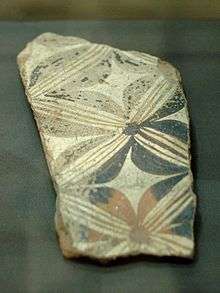Corpus vasorum antiquorum
Corpus Vasorum Antiquorum ("corpus of ancient vases"; abbreviated CVA) is an international research project for ceramic documentation of the classical area.
CVA is the first and oldest research project of the Union Académique Internationale of France. The first project meeting was organized by Edmond Pottier in Paris in 1919. The final decision was to publish a comprehensive catalogue of ancient Greek vases. He was also the publisher of the first fascicle for the Louvre in 1922. At that time six countries were part of the project. Today the project covers a compendium of more than 100,000 vases located in collections of 26 participating countries. At present day only public collections located in museums are added to the catalogue.
Every participating country is completely responsible for its own scope, while the Union Académique Internationale in Brussels has the patronage traditionally led by a French scientist. Currently in charge is Juliette de La Genière.
| Country | Current leader | Organization | since |
|---|---|---|---|
| Austria | Claudia Lang-Auinger | Austrian Academy of Sciences | 1935 |
| Germany | Paul Zanker | Bavarian Academy of Sciences | 1921 |
| Great Britain | Dr Thomas Mannack | British Academy | 1925[1] |
| Switzerland | Hans Peter Isler | Schweizerischen Akademie der Geistes- und Sozialwissenschaften |
The CVA publishes Greek and Italian ceramics of the classical period between the seventh millennium B.C. and the late Antiquity (third-fifth century A.D.). The publications are divided into fascicles by country and museum. By the end of 2007 a total of 350 volumes consisting of 40,000 fascicles were published. One of the largest amounts of publications was done in Germany: 84 volumes and 3 supplements.
Since 2004 all textual descriptions and images are freely accessible as a web-based database (CVA Online). Languages allowed for publication are English, French, German and Italian. Further publication rules have to be fulfilled. This often requires a restoration of the actual objects. For example: fragments have to be distinctively different from restored parts. For older restorations this is often not the case.
The documentation of a vessel is done in several steps. First the vessel is described in its overall condition followed by an iconographic interpretation. If possible an artist or a workshop will be determined. Integral parts of the documentation are photographs and hand-drawings depending on the condition of the vessel and the projects budget. The Austrian commission used for the first-time of the CVA a 3D-Scanner for documentation of vessel shapes.[2][3] A follow-up project using 3D-Acquisition has been granted.[4] The last step of the documentation is a chronologic classification.
See also
Citations
- ↑ http://www.britac.ac.uk/pubs/cat/cva.cfm
- ↑ Hubert Mara; Elisabeth Trinkl; Paul Kammerer; Ernestine Zolda (2007). "3D-Acquisition and Multi-Spectral Readings for Documentation of Polychrome Ceramics in the Antiquities Collection of the Kunsthistorisches Museum Vienna". Proceedings of the International Cultural Heritage Informatics Meeting (ICHIM). External link in
|title=(help) - ↑ Kunsthistorisches Museum - Antikensammlung (2009-12-09), Scientific projects of the KHM: Corpus Vasorum Antiquorum KHM Band 5 (Attisch rotfigurige Vasen Band 4, online services and annual report External link in
|title=(help) - ↑ Austrian Science Foundation (FWF) (06.10.2007), Attische Keramik im KHM Wien, online services Check date values in:
|date=(help)
Sources
- Colloque International sur le Corpus Vasorum Antiquorum (Lyon, 3–5 juillet 1956), compte rendu réd. par Charles Dugas. Paris 1957.
- Summary guide to "Corpus Vasorum Antiquorum", compiled by Thomas H. Carpenter and updated by Thomas Mannack. 2. ed. Oxford 2000, ISBN 0-19-726203-1.
- Donna C. Kurtz: A corpus of ancient vases. Hommage à Edmond Pottier. In: Revue Archéologique 2004. S. 259–286.
- Elisabeth Trinkl: Interdisziplinäre Dokumentations- und Visualisierungsmethoden, CVA Österreich Beiheft 1 Verlag der Österreichischen Akademie der Wissenschaften (VÖAW), ISBN 978-3-7001-7145-4, ISBN 978-3-7001-7544-5 (Online), Wien, Österreich, 2013
External links
- Official website
- CVA at the Union Académique Internationale (in French)
- CVA Commission Germany of the Bavarian Academy of Sciences (in German)
- CVA Commission Austria (in German)
- List of all Publications
